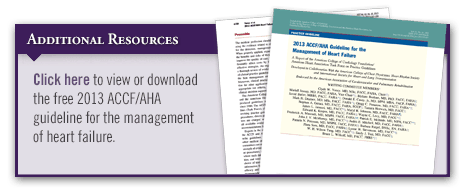According to recent estimates, heart failure (HF) currently affects about 6 million adults in the United States, and the prevalence is projected to increase 25% by 2030. When HF patients are hospitalized, it represents a turning point in the natural history of their disease. “About 25% of HF patients who are discharged from the hospital are readmitted within 30 days,” says Clyde W. Yancy, MD, MSc, FACC. HF patients often need to be readmitted because the underlying cause of HF worsens. Hospitalizations are responsible for the majority of the nearly $40 billion that is spent annually for HF care in the U.S. As a result, these hospitalizations have become a focal point for quality improvement efforts and initiatives aimed at reducing costs.
In an effort to improve outcomes, CMS has mandated that hospitals report their 30-day readmission rates for HF and acute myocardial infarction (AMI). The problem with this approach, according to Dr. Yancy, is that public reporting of outcomes is not effective as a hospital performance indicator. “Readmission rates, particularly for HF, are not a good marker of quality of care,” he says. “The emphasis on 30-day readmissions is misguided because the primary driver of these events is often patient population and the community that is served by hospitals.” Clinical investigations have also suggested that public reporting does not provide effective incentives for improvement and has had only minor effects on outcomes.
Widespread Concern
The changing paradigm to deny payment for HF readmissions within 30 days of discharge has led to widespread concern across hospitals. “Implementing HF programs and readmission reduction strategies are undertakings that require significant analysis, planning, preparation, and execution,” explains Dr. Yancy. “These efforts, however, are important because of the large number of HF readmissions being reported and because policy changes are now focusing on reducing costs, aligning incentives properly, and improving quality. When identifying and executing strategies, a structured approach to assessment and implementation can ensure the highest likelihood of success.”
Guideline Adherence
Many hospitals and healthcare systems are focusing on improving performance and patient outcomes in cardiovascular services, with a particular emphasis on how the management of HF can prevent readmissions, decrease costs per case, and improve quality and patient satisfaction. “Study after study has shown that adherence to clinical practice guidelines is associated with improved outcomes,” Dr. Yancy says. “Increasing guideline adherence represents an ideal quality initiative for HF.” He also notes that quality outcomes and optimal lifestyle management of HF will be deciding factors in patient choice about healthcare providers and systems.
Guidelines are available to assist clinicians in the care of HF patients with preserved ejection fraction (Table 1) and reduced left ventricular ejection fraction (Table 2). “Adhering to guideline-directed medical therapies (GDMT) when managing HF patients can significantly reduce the risk of HF hospitalizations,” says Dr. Yancy. “Using GDMT during the initial treatment of patients may, in turn, reduce HF readmissions.”
Hospital Discharge
Using performance improvement systems in the hospital and early in post-discharge outpatient settings is paramount. According to guidelines, several factors should be addressed with HF patients before hospital discharge, at the first post-discharge visit, and in subsequent follow-up visits:
* GDMT should be initiated if it was not previously provided or was contraindicated.
* The causes of HF, barriers to care, and limitations in support for patients should be identified.
* Volume status and blood pressure should be assessed as HF therapies are adjusted.
* Chronic oral HF therapy should be optimized.
* Renal function and electrolytes should be monitored and managed.
* Comorbid conditions should be managed.
* Education on HF, self-care, emergency plans, and adherence to therapy should be provided to patients.
* Consideration should be made for palliative or hospice care, when appropriate.
A Team Effort
“Ensuring that a multidisciplinary disease-management program is utilized in HF patients at high risk for hospital readmission is critical,” says Dr. Yancy. He adds that a follow-up visit within 7 to 14 days and/or a telephone follow-up within 3 days of hospital discharge is reasonable. Clinical risk-prediction tools and/or biomarkers should be used to identify higher-risk patients.
Clinical studies are continuing to identify strategies that can have a modest effect on reducing HF readmissions. Dr. Yancy says that hospitals should be cautious about launching resources toward only one or a few steps to reduce HF readmissions. “Our healthcare system is dysfunctional,” he says, “and addressing only some of the factors relating to HF readmissions will result in a small effect at best. HF readmissions are not a problem that one physician or one nurse can fix. It requires engagement from a comprehensive clinical discharge team, effective follow-up practices, and working with patients and their caregivers to ensure that they’re adhering to their treatment regimens.”




 TimH
TimH